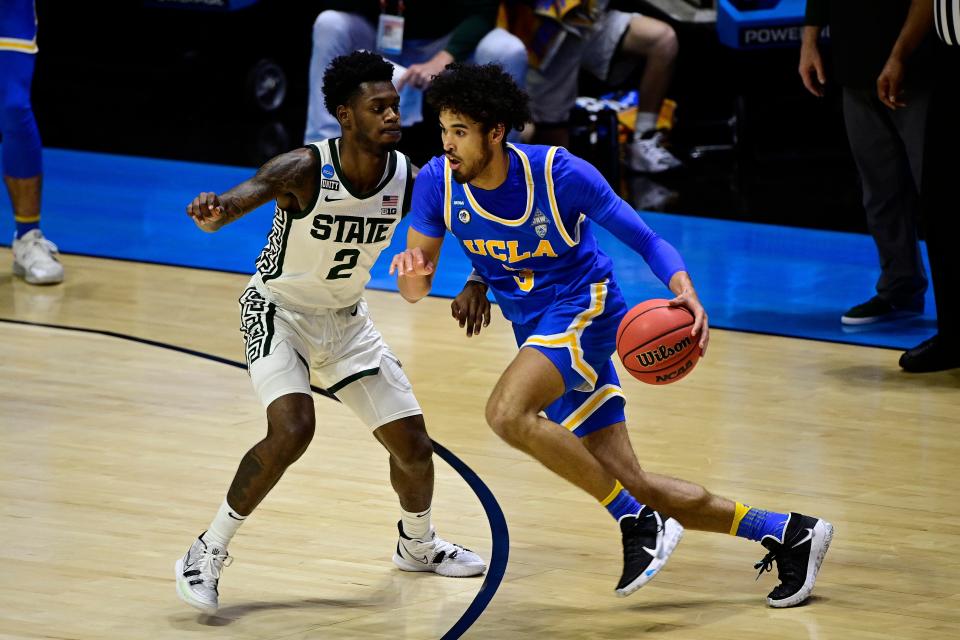Opinion: Monetizing men's college basketball helps preserve its future
For the past decade, college basketball has suffered from a steady erosion of talent born mostly out of the sport’s stubborn refusal to make its rules more flexible. Rather than find ways to convince the most talented young players in the world that the opportunity to play in college was worth their time, even if just for a year, the NCAA kept erecting barriers and telling future pros they should find alternative paths to the NBA if being an amateur wasn’t their No. 1 priority.
More and more, elite players took that message to heart, signing contracts overseas or finding domestic opportunities in the NBA G League.
Even for players who entered college, the goal for many of them has been to get out as fast as they can to make money playing basketball, even if it wasn’t likely to be in the NBA.
But the 2021-22 season represents an accidental renaissance for college basketball. With the NCAA finally relenting on rules that prohibited players from making money off their name, image and likeness, we’re going to once again see the vast majority of top prospects on college campuses this winter and ultimately playing in March Madness.
Which is exactly how it should be.

Had the NCAA not been pressured by state legislatures across the country and by Congress to reform its rules and allow players to make money on marketing deals, you wouldn’t have seen projected top-10 picks like Emoni Bates and Jalen Duren enroll at Memphis. And you might not have seen established stars like Michigan center Hunter Dickinson or UCLA’s Johnny Juzang decide to come back to college after breakout seasons.
DON'T MISS: Five must-watch early season men's college basketball games
BEST OF BEST: The 15 players on the USA TODAY Sports Alll-America team
“The NIL stuff had a factor into my decision,” Dickinson told ESPN in July when he announced his decision to come back as a sophomore. “Being able to make a little extra money and not have to worry about my financial situation while at school is definitely a (plus).”
Obviously, projected lottery picks are going to leave for the NBA at the first opportunity in most cases, regardless of NIL possibilities. And if the NBA ever gets around to changing its draft eligibility to allow direct entry from high school, a lot of those prospects will opt to skip college.
But college basketball has always had a great case to make that it’s the best developmental option available for young American players who want to go to the NBA.
Besides the obvious social and academic benefits from even a year on a college campus, players at top programs get treated like royalty, whether it’s flying on charter planes and staying at five-star hotels, having incredible training facilities at their disposal or playing games on national television in front of packed houses.
It’s a far cry from the long bus rides and commercial flights into small towns that players experience in the minor league lifestyle, having to grind it out against grown men who are desperate to earn a 10-day NBA contract.
Moreover, players like Kevin Durant, Derrick Rose and Zion Williamson came into the NBA as ready-made superstars because they’d already built a brand in college and were able to sign even bigger marketing deals as NBA rookies.
Despite those obvious benefits, college basketball had been viewed as increasingly unnecessary by top players. In the 2021 NBA draft, No. 2 pick Jalen Green and No. 7 pick Jonathan Kuminga came out of the G League Ignite program. In 2020, eligibility issues around No. 2 pick James Wiseman forced him to leave Memphis after playing just three games while No. 3 pick LaMelo Ball came out of the Australian pro league and won NBA Rookie of the Year.
There may still be top prospects in the future who have no interest in playing college basketball, but at least NIL gives these programs a fighting chance.
MJ Rice, a five-star wing from California who committed to enroll at Kansas next year, told Sports Illustrated recently that NIL opportunities “tipped the scale to college,” while Duke freshman Paolo Banchero recently signed a deal to become the first college player in the NBA 2K video game.
Until this summer, Bates was one of those recruits who was nationally known at age 15 yet seemed destined to never play a second of college basketball. While it’s still a gray area about what role that schools should have in arranging these deals, it’s believed Bates will have the chance to make several hundred thousand dollars by playing for Memphis.
“You can come to college now and get deals for yourself and learn and develop at the same time,” Memphis coach Penny Hardaway told reporters. “You don’t have to go to any other level to get that.”
Regardless of how fans or NCAA officials feel about so much money that is now connected to these top prospects and their college choices, the bottom line will be an infusion to the sport’s overall talent level. While March Madness is always a great event, it’s even better when we can watch future superstars lay the groundwork for their pro careers.
The NCAA may have fought against players being able to profit off their name, image and likeness. But now that it’s here, college basketball will be able to reap the rewards for years to come.
Follow USA TODAY Sports columnist Dan Wolken on Twitter @DanWolken
This article originally appeared on USA TODAY: College basketball needs NIL, monetization to help preserve game

